Back on May 25 of this year, on this post about Lark Sparrows, I made the following statement at the end of the post:
“Now that I have some decent images of this species my next goal with them is to capture some of their unique behaviors. These birds often pass a twig from the male to the female during copulation (an impressive display of multitasking and concentration). And they do a turkey-like strut during courtship. I would love to capture either behavior.”
In your comments, several of you gave me encouragement in meeting that goal and 11 days later I was at least partly able to do so. These are those images.
A couple of these photos may be a little “clinical” for some, but to me it’s all behavior and it’s all interesting. Techs for all images were: 1/4000 or 1/3200, f/6.3, ISO 640, 500 f/4, 1.4 tc
The courtship of Lark Sparrows includes behaviors found in no other songbirds. Prior to actual mating, the male struts like a turkey, with its tail sticking up to show off its white tail spots and its wings drooping to the ground. Then, before the male mounts her, he picks up a twig (or twigs) which he passes to the female just before copulation. When mating is complete (they may mate or attempt to mate up to 20 times in 3.5 minutes) the female often flies off with the twig.

The courtship had already begun when I approached this mated pair. Normally, this species doesn’t allow me to get this close but I suspect they were so intent on their activities that they weren’t about to allow something as trivial as a 5,000 lb pickup with two humans inside clicking away at them to interfere with their nuptials. As you can see, the female has already been presented with the twig. I don’t know how many times copulation may have already occurred by the time I got into position to take photographs.
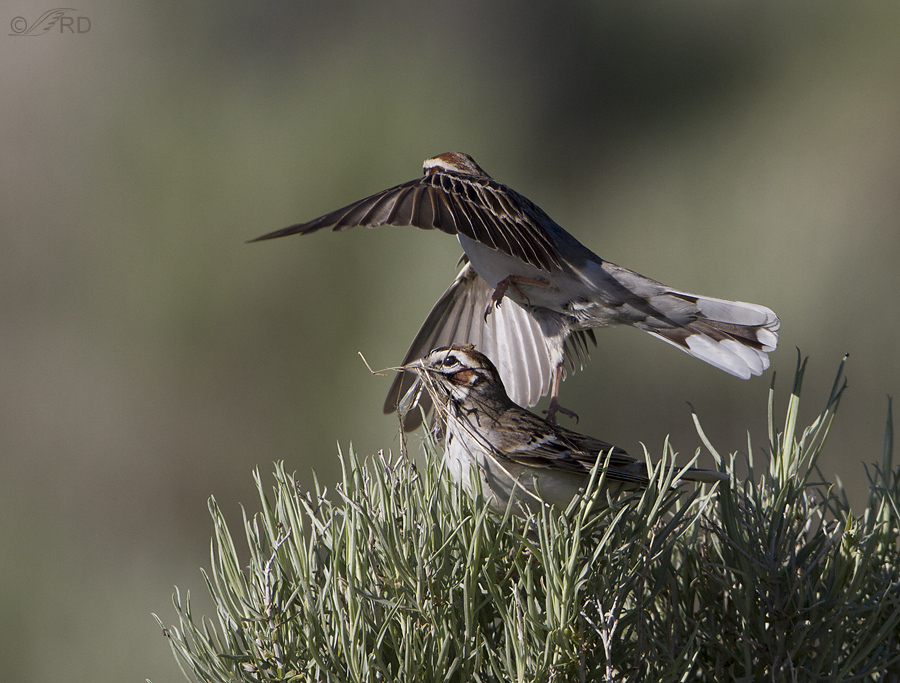
After copulation, the male would take off…
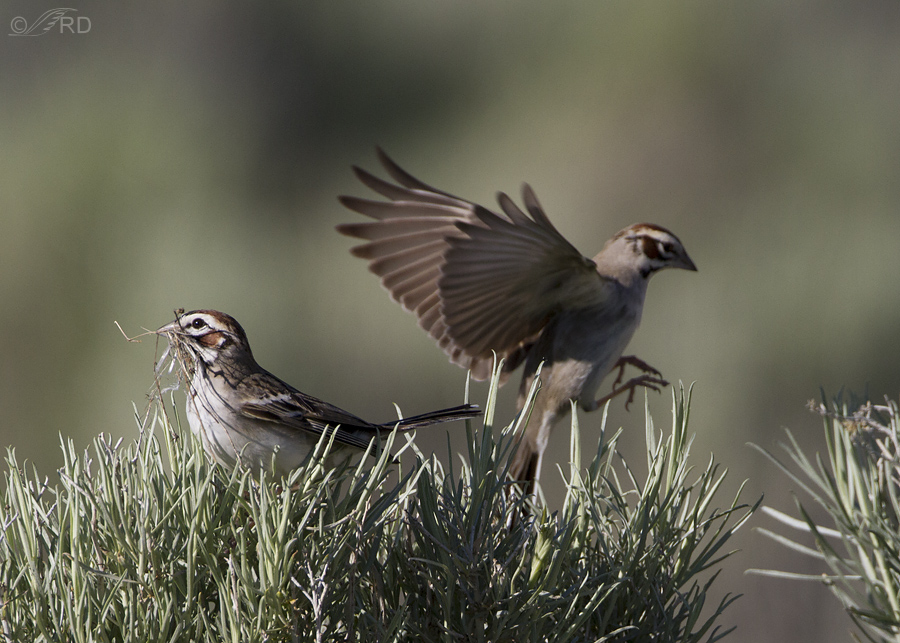
and land on a nearby perch (the one to the right of the frame), wait a few seconds…
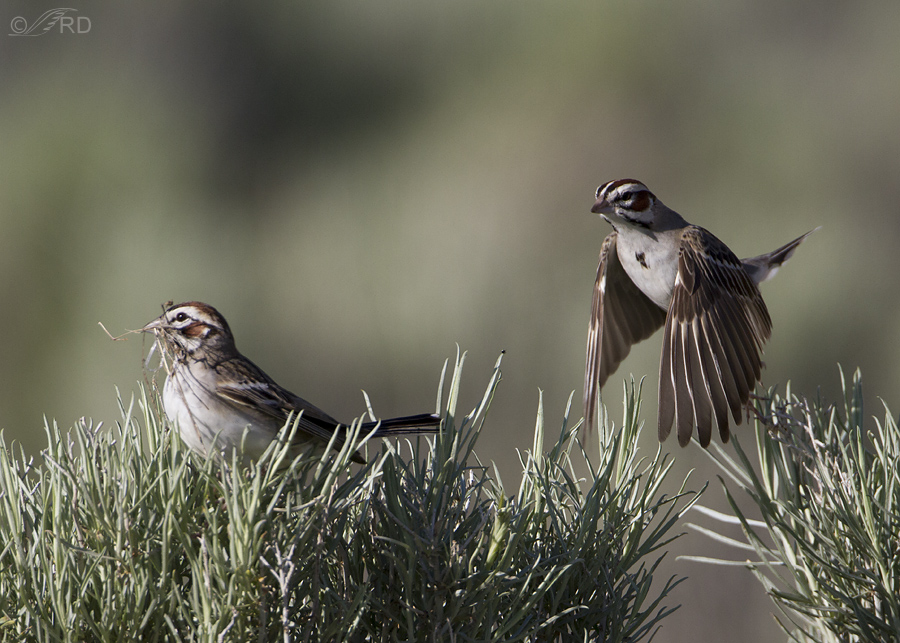
and then return to the waiting female…
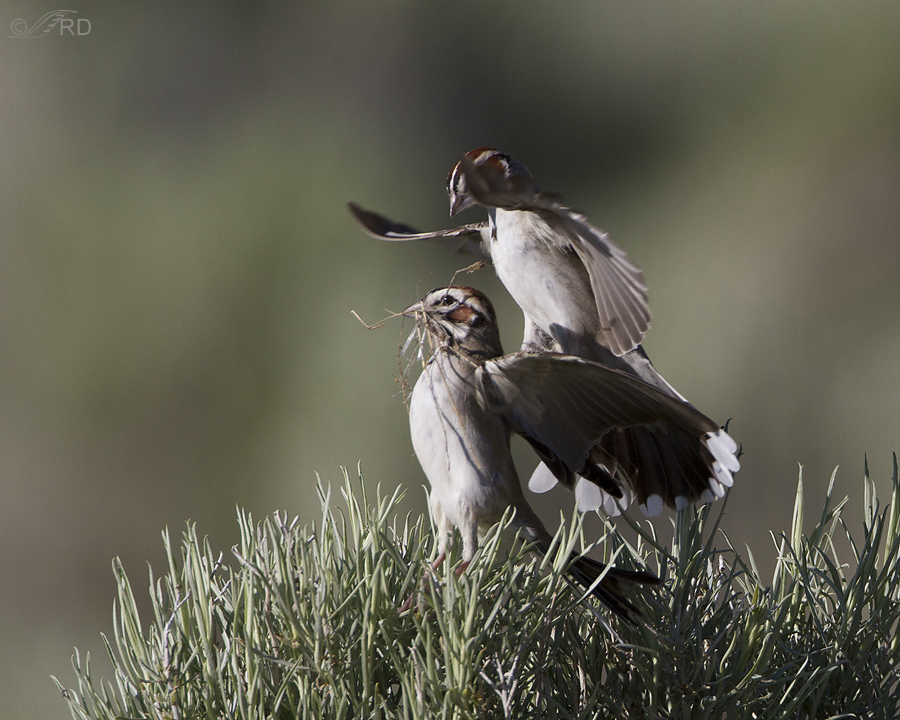
for another go at it.
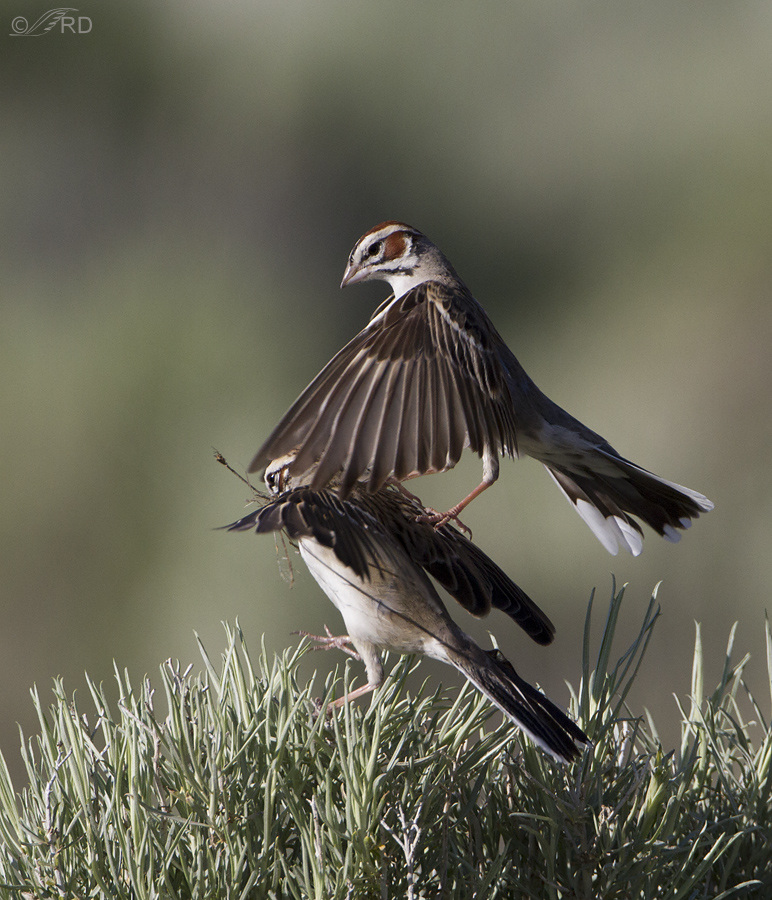
Her back wasn’t a stable platform…
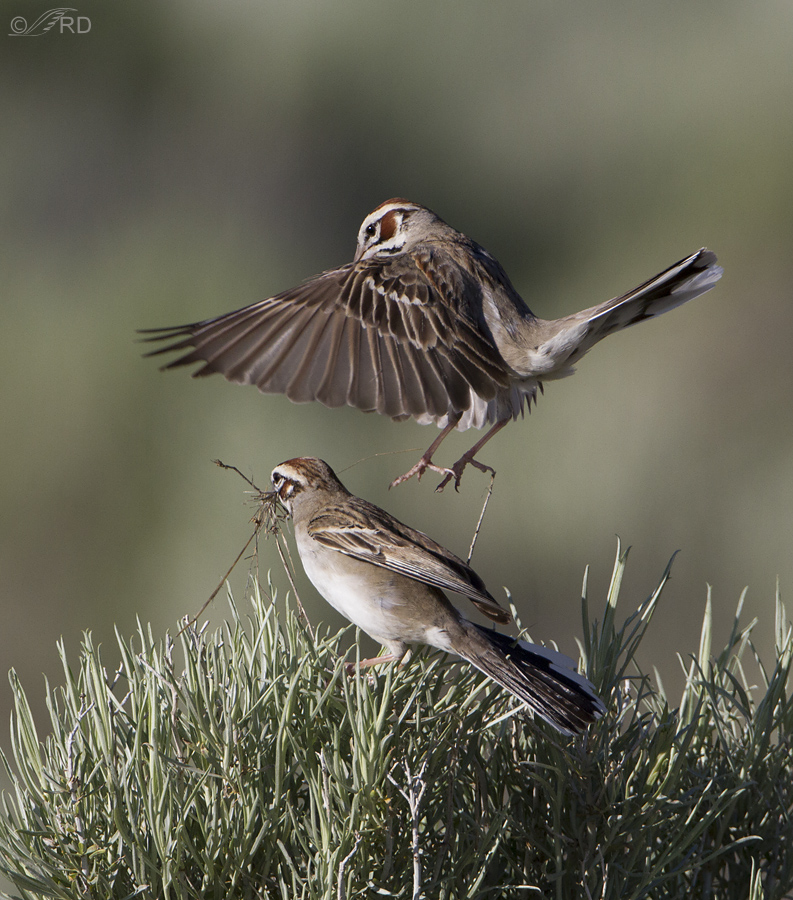
and he often had to make several “touch and go” landings before…
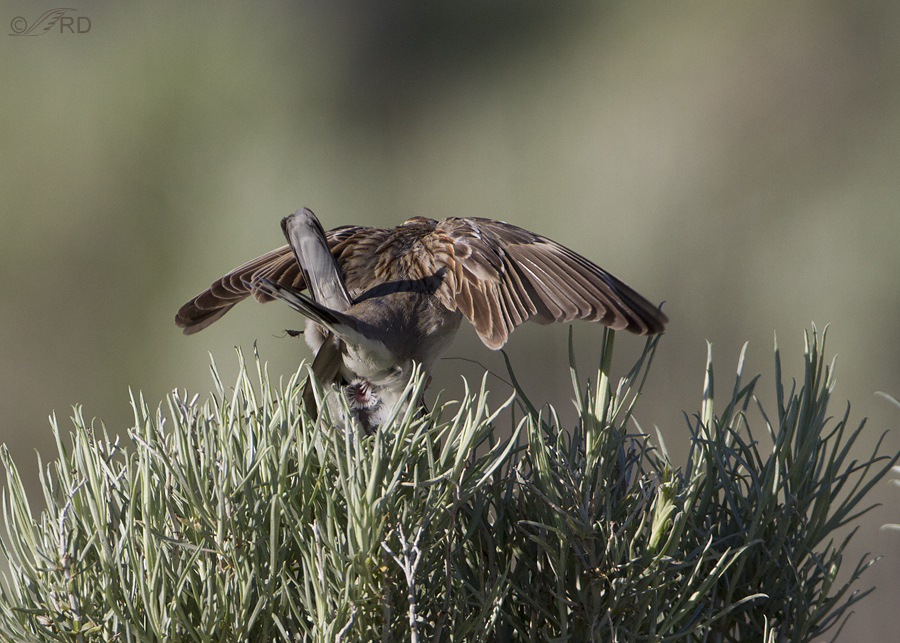
an actual copulation was concluded. Copulation in most bird species (those without an intromittent organ or penis) has been referred to as the “cloacal kiss” because the male and female must actually touch cloacal openings to pass sperm from the male to the female. Here you can see the exposed cloacal opening of the female just prior to copulation.
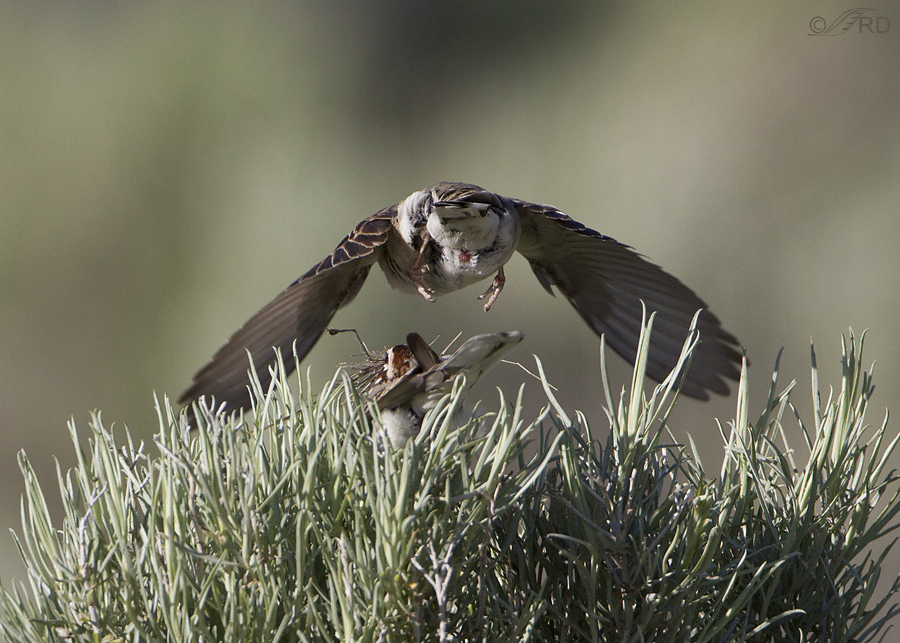
And in this image you can see the cloacal opening of the male as he flies off immediately after mating.
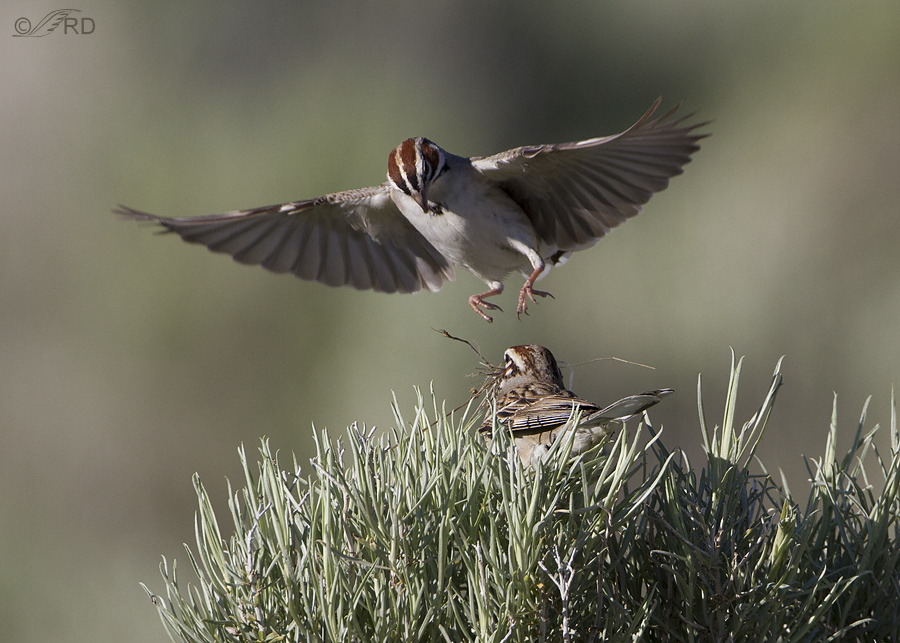
He returns to the female (notice that she still has the twigs in her beak)…
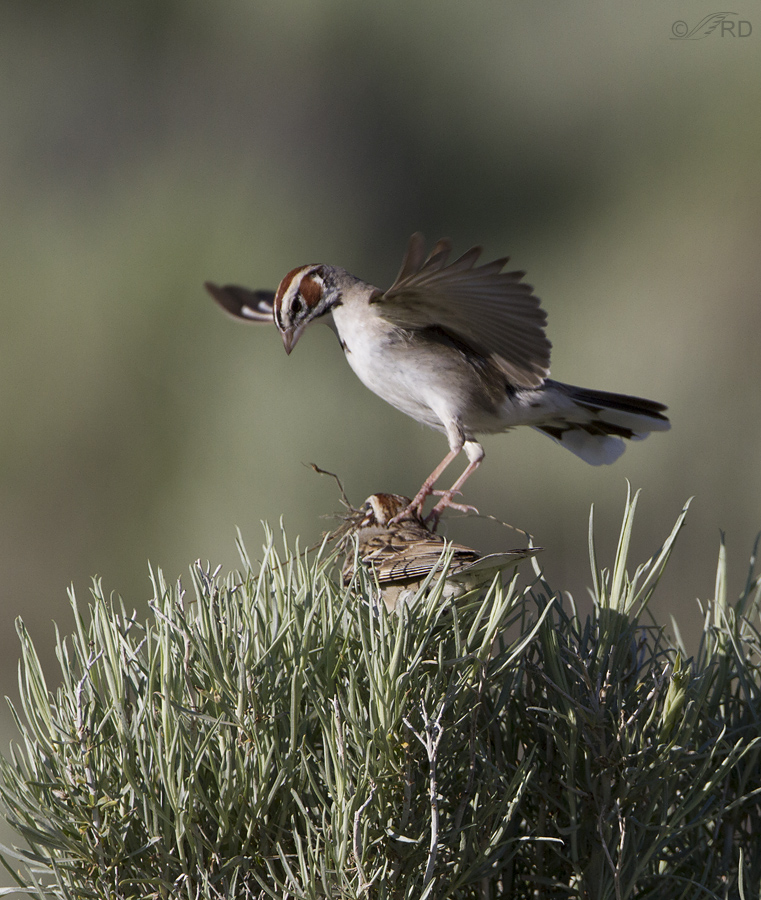
then lands on her back..
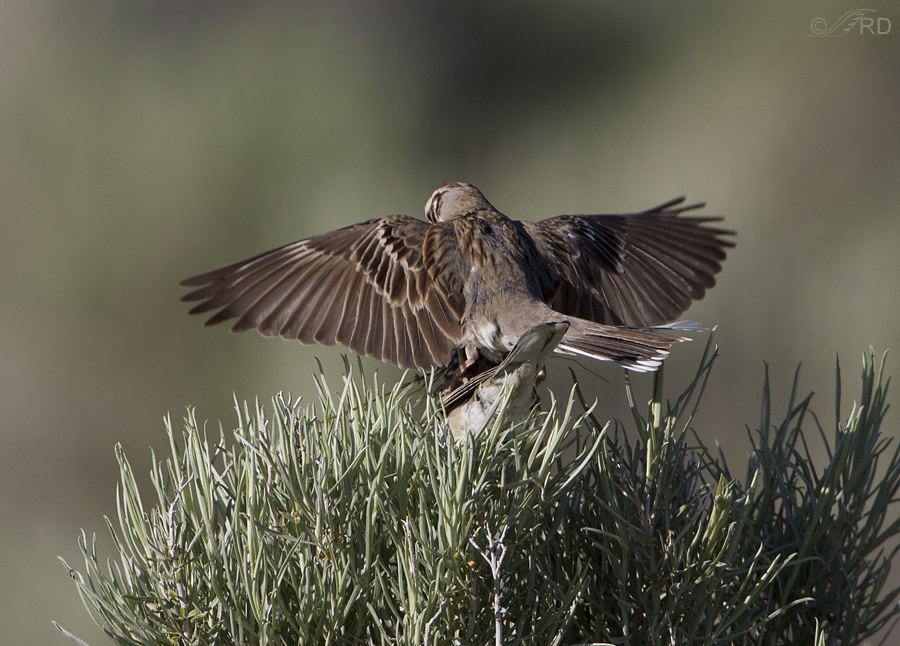
and they mate once again.
This went on for a good long while and I don’t remember how many times I saw them actually mate. The action was fast and furious and the photography difficult. In between matings I didn’t know where to focus – on the female as she waited for the male or on the male at the other perch to try to get him in flight as he approached her. Often I made the wrong choice and most of the actual flight shots weren’t sharp enough. And because of the light angle I seldom got catch lights in the eyes.
But I’m always delighted to be able to photograph interesting behaviors like this and it’s a very special feeling when birds allow me to observe such intimate behaviors up close.
Maybe next time I’ll be able to catch the “turkey strut” of the male. What fun that would be!
Ron


I feel educated and am looking at this from an interested curious view, not “birdie porn”. Great shots of the behaviour but somewhat offended that she has to be ready to make the nest, I am guessing, before the act is even over.
I have always wondered how birds manage to mate with the female’s tale in the way, and the times I have observed it, the action is, as you put it Ron, too fast & furious for me to understand it. Thanks for posting these shots, very interesting as well as beautiful!
Oh good grief: *tail*
Ron:
Amazing series. I missed this when you posted it originally. Thanks for bringing it to my attention in your recent blog entry.
I’m amazed! That’s a wonderful sequence of photos, and the play-by-play description is much appreciated.
Thanks very much, Steve. Glad you liked the description, too.
What a wonderful series! Thanks so much for sharing your fantastic talent.
I’m delighted that you liked the series, Charlotte.
I agree with all of the comments about how fascinating this post is. It is *so* difficult finding and capturing these scenarios, I admit I’m not sure how you do it so beautifully and consistently, and you should guard your trade secret closely. I had no idea about this behavior and am happy to learn about it.
I had no idea about this behavior and am happy to learn about it.
I have a confession to make, Ingrid. I “knew” about this behavior but didn’t recognize that I’d captured it the first time I viewed the images. Really don’t know how I missed it. Then, 6 months later, (a few nights ago) as I’m going through some old images, shazaam! – there it was and I recognized it. I’m pretty dense sometimes…
Wonderful blog page. I learn so much from your amazing information and your astonishing photography. Thanks again. I read your blog everyday!
Delighted to hear it, Teri. And I’m glad that you appreciate the information, in addition to the images.
GREAT shots and interesting read on the behavior. Thank you for sharing!!
Thanks for commenting, Mark.
More terrific information and a very interesting read. Oh, and pretty spectacular images, too!
Thank you Wally, on all three counts
Hey now, wait a minute Ron, many of us non-biologists have an abiding curiosity and quest for knowledge about the natural world. No offense taken though, lol! I love your blog…
Sorry Susan, I surely didn’t mean to imply such a thing.
This post is great Ron. Well documented behavior, and informative narrative. Just the stuff I love to see!
Thanks, Bryce. Maybe it’s the “biologist” background that we share that makes this kind of thing so appealing to us…
Great depiction of this act, and I finally got the term straight: “Cloacal Kissing”, I was able to film, however, the mounting of a Muskovy duck, with his “corkscrew” penis, here: http://birdsfromthecaribbean.blogspot.com/2012/09/the-mating-act-of-muskovy-duck-cairina.html, if you’re interested.
I’m always interested in stuff like that, Maria. You got some interesting shots of that strangely shaped intromittent organ or penis that some birds have, especially waterfowl. It’s thought that waterfowl may have evolved a penis to prevent water from washing away the sperm during mating.
Thanks Ron, I was very busy photographing the act, and I now wonder if this was an event that was supposed to happen when they are in the water, because I never really saw the actual penetration of his organ in her vagina, but apparently it does seem to happen when they’re out of the water too.
Ron: I found a wonderful article in the New York Times, apparently they mate both in land and in water, but I will let you just read on: http://www.nytimes.com/2007/05/01/science/01duck.html?pagewanted=1&_r=0&adxnnl=1&adxnnlx=1354665417-47/CsjtZJ8tEtA6Ne22QBQ
WARNING: this article describes scientific experiments on ducks that may harm the sensibility of those opposed to such procedures performed on animals and may violate animal ethical treatment standards.
A fascinating article, Maria. As a biology teacher, this is the kind of thing that always intrigued me. Thanks.
I was wondering about the twig myself, and wondered whether it was a symbolic nesting gesture. And then I realised that birds are not really all that into symbolism and you mentioned that the pragmatic Lark Sparrow uses/reuses old nests. And I am interested in, fascinated by all bird behaviour. It occupies many hours here and while some might consider them wasted hours I don’t agree. Another wonderful series – thank you.
Elephant’s Child, I wondered if the presence of the twig in the beak was a signal to the male that the female continues to be receptive to his advances, since she always has it in her beak during the mating process. Speculation on my part, of course…
Wow! Interesting, informative and action packed! Thanks for another great introduction to my day! Who knew? Not me, obviously, but now I have a whole new way to see those little busy bodies when they visit us down south. How about getting this close to some meadowlarks? You are amazing!
Tana, I don’t have any photos of unique behaviors of meadowlarks but I’ll try to work up an appropriate post of that species soon Thank you.
Thanks Ron, appreciate such details, so very interesting!
Thanks, Blue Page. I find it very interesting also.
Absolutely fascinating! I find the behavior with the twig, well, hate to use that word again, but fascinating! Why? What does it mean? Why do these particular birds have this behavior and others don’t? What exactly does she do with the twig after she flies away?
Leisa, It’s thought that the behavior with the twig might be an alteration of “courtship feeding” that is found in other species. I don’t know what happens to the twig after she flies away with it, especially because with this species the female often takes over old (or even active) nests of other species, so I’d assume that in those cases at least the twig wouldn’t be used for nest building. Interesting, huh?